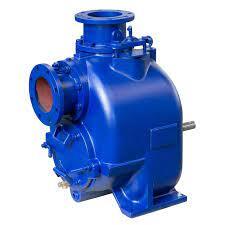What is a Self Priming Portable Trash Pump?

A self priming portable trash pump is an essential piece of equipment for handling demanding water transfer jobs. Designed to move large volumes of water containing debris, these pumps are widely used in construction, agriculture, emergency flood response, and municipal maintenance. Whether you need to clear floodwater, empty a pond, or keep a worksite dry, a self priming portable trash pump offers the efficiency, mobility, and durability you need.
A self priming portable trash pump is a type of centrifugal pump designed to handle water that contains solids, mud, leaves, or other debris. The “self priming” feature means it can automatically remove air from the pump and suction line, allowing it to start pumping without manual priming. Being portable, it is mounted on a lightweight frame or wheels, making it easy to transport to different job sites.
Unlike standard water pumps, trash pumps have larger impellers and wider openings, allowing solids to pass through without clogging. This makes them ideal for challenging pumping applications where water is not perfectly clean.
How Does a Self Priming Portable Trash Pump Work?
The self priming function relies on a combination of water and air separation inside the pump casing. When started, the pump uses the liquid stored in the casing to create a vacuum, drawing water up from the source. The air is expelled through the discharge side, and once the casing is filled, the pump begins continuous operation. Because of this design, these pumps can be restarted without the need to manually refill them with water every time.
The portability factor is equally important. Many models are powered by gasoline or diesel engines, making them independent from electrical power sources. This allows for use in remote areas or during emergencies where electricity is unavailable.
Key Features and Benefits
1. Self Priming Capability
The ability to self prime eliminates downtime and makes operation simpler. Once the pump is initially filled, it can automatically re prime after interruptions without additional work.
2. High Solid Handling Capacity
These pumps can handle solids ranging from 1 to 3 inches in diameter, depending on the model. This ensures efficient pumping even in dirty water conditions.
3. Portability and Ease of Use
Most self priming portable trash pumps are mounted on steel frames with handles or wheel kits, making them easy to move around job sites.
4. Heavy Duty Durability
Built with cast iron, stainless steel, or reinforced aluminum components, these pumps are designed to withstand tough environments and frequent use.
5. Versatile Applications
From construction sites to agricultural fields, a self priming portable trash pump can handle irrigation, dewatering, and flood control with equal efficiency.
Common Applications
- Construction Sites: Removing standing water from foundations, trenches, or excavation areas.
- Flood Control: Rapid removal of floodwater from streets, basements, and low lying areas.
- Agriculture: Irrigation, pond management, and drainage.
- Municipal Services: Clearing storm drains and maintenance of sewer bypass systems.
- Emergency Response: Quick deployment during natural disasters for water removal and relief operations.
Choosing the Right Self Priming Portable Trash Pump
Selecting the right pump involves evaluating several factors to match your specific needs:
Pump Size and Capacity
The pump’s flow rate, measured in gallons per minute (GPM), determines how quickly it can move water. Larger capacity pumps handle more water but may be heavier and require more fuel.
Solid Handling Capability
Check the maximum solid size rating to ensure it can handle the debris in your water source.
Engine Type
Gasoline powered pumps are common for smaller jobs, while diesel engines are preferred for heavy duty and long duration applications due to their efficiency.
Portability Features
If you frequently move the pump, consider models with wheel kits, lightweight frames, and lifting hooks for easier transportation.
Build Material
For corrosive or abrasive water conditions, pumps made of stainless steel or cast iron offer better durability.
Maintenance Tips for Longer Lifespan
Maintaining your self priming portable trash pump ensures it operates efficiently for years:
- Inspect Before Use: Check hoses, clamps, and fittings for leaks or wear.
- Clean After Use: Flush the pump casing with clean water to prevent debris buildup.
- Monitor Oil and Fuel Levels: Ensure the engine is properly lubricated and fueled.
- Replace Worn Parts: Impellers, seals, and gaskets should be replaced when worn to maintain performance.
- Store Properly: Keep the pump in a dry, sheltered location when not in use.
Advantages Over Other Pump Types
Compared to submersible pumps or non self priming centrifugal pumps, the self priming portable trash pump offers faster setup, greater versatility, and better mobility. It can operate in environments with limited access to electricity and can handle a wider range of debris filled water sources without clogging.
Safety Considerations
When operating a self priming portable trash pump, follow all manufacturer guidelines. Always wear protective gear such as gloves and safety goggles, especially when handling contaminated water. Ensure the pump is on stable ground to prevent tipping during operation, and keep flammable materials away from gasoline or diesel powered units.
Conclusion
A self priming portable trash pump is a versatile, durable, and efficient solution for handling tough water transfer jobs. Its ability to self prime, handle solids, and operate in remote locations makes it a valuable tool for construction, agriculture, emergency services, and municipal maintenance. By choosing the right model and maintaining it properly, you can ensure reliable performance for years to come.
Whether you are clearing floodwater, draining a construction site, or managing agricultural irrigation, a self priming portable trash pumps delivers the power and flexibility you need to get the job done quickly and efficiently.



